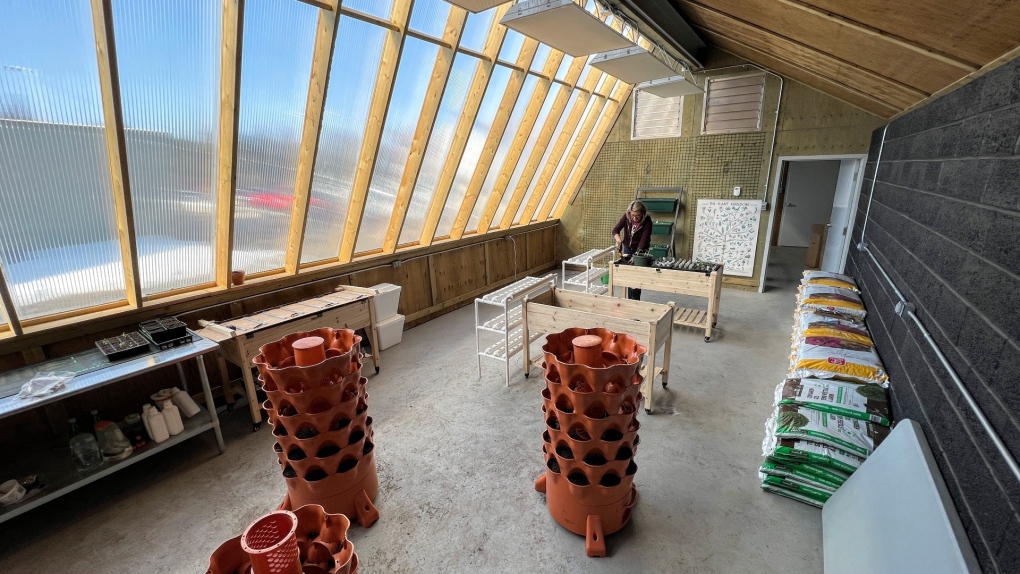University's greenhouse could help address food insecurity in northern Manitoba
One Manitoba university is operating a near-net-zero energy greenhouse on one of its campuses that could one day help address food insecurity in northern Manitoba.
The University College of the North (UCN) said it built the greenhouse on its campus in The Pas to improve food sovereignty, community health, and student learning opportunities.
Katrin Stedronsky, assistant professor in the Faculty of Arts, Business and Science at UCN, said it was designed “strictly for proof of concept of year-round production of produce with sustainability at the centre of it.”
The facility’s main heat reservoir is Biofibre blocks, which absorb light energy. The blocks were built based on a Canadian design and are made from Canadian-sourced hemp. They were also designed to capitalize on heat retention.
“[The greenhouse was designed] so we can have that year-round production of produce in northern communities where they don’t necessarily have availability for fresh produce as readily,” Stedronsky said.
“A lot of that produce is shipped in from the south.”
She noted the transport of produce and perishables into northern regions often ends up costing community members a lot of money.
“Having this greenhouse in place would help reduce that cost,” Stedronsky said, noting the UCN greenhouse is just a test run.
 Supplied image of the greenhouse on the UCN campus in The Pas.
Supplied image of the greenhouse on the UCN campus in The Pas.
The greenhouse will be used to produce multiple growth systems. Seedlings for a variety of herbs and produce, including tomatoes, peppers, cucumbers, beans and spinach, have been planted and are already starting to grow. Most of this produce will be used in the campus cafeteria for culinary arts students and staff.
“We are starting to get growth. So we’ve got a lot of basil growing, parsley, we’ve got tomato plants growing. So there’s growth already in the greenhouse,” Stedronsky said.
“It’s going well. We’ve just had some issues gaining access to soil over the winter months.”
She noted they are looking at having produce by the end of June and will continue seeding all the growing systems to maintain the growth year-round.
If this project is successful, this type of greenhouse can be tested even further north.
- With files from CTV’s Devon McKendrick.
CTVNews.ca Top Stories

Trump threatens to try to take back the Panama Canal. Panama's president balks at the suggestion
Donald Trump suggested Sunday that his new administration could try to regain control of the Panama Canal that the United States “foolishly” ceded to its Central American ally, contending that shippers are charged “ridiculous” fees to pass through the vital transportation channel linking the Atlantic and Pacific Oceans.
Man handed 5th distracted driving charge for using cell phone on Hwy. 417 in Ottawa
An Ottawa driver was charged for using a cell phone behind the wheel on Sunday, the fifth time he has faced distracted driving charges.
Wrongfully convicted N.B. man has mixed feelings since exoneration
Robert Mailman, 76, was exonerated on Jan. 4 of a 1983 murder for which he and his friend Walter Gillespie served lengthy prison terms.
Can the Governor General do what Pierre Poilievre is asking? This expert says no
A historically difficult week for Prime Minister Justin Trudeau and his Liberal government ended with a renewed push from Conservative Leader Pierre Poilievre to topple this government – this time in the form a letter to the Governor General.
opinion Christmas movies for people who don't like Christmas movies
The holidays can bring up a whole gamut of emotions, not just love and goodwill. So CTV film critic Richard Crouse offers up a list of Christmas movies for people who might not enjoy traditional Christmas movies.
More than 7,000 Jeep SUVs recalled in Canada over camera display concern
A software issue potentially affecting the rearview camera display in select Jeep Wagoneer and Grand Cherokee models has prompted a recall of more than 7,000 vehicles.
'I'm still thinking pinch me': lost puppy reunited with family after five years
After almost five years of searching and never giving up hope, the Tuffin family received the best Christmas gift they could have hoped for: being reunited with their long-lost puppy.
10 hospitalized after carbon monoxide poisoning in Ottawa's east end
The Ottawa Police Service says ten people were taken to hospital, with one of them in life-threatening condition, after being exposed to carbon monoxide in the neighbourhood of Vanier on Sunday morning.
New York City police apprehend suspect in the death of a woman found on fire in a subway car
New York City police announced Sunday they have in custody a “person of interest” in the early morning death of a woman who they believe may have fallen asleep on a stationary subway train before being intentionally lit on fire by a man she didn't know.


































